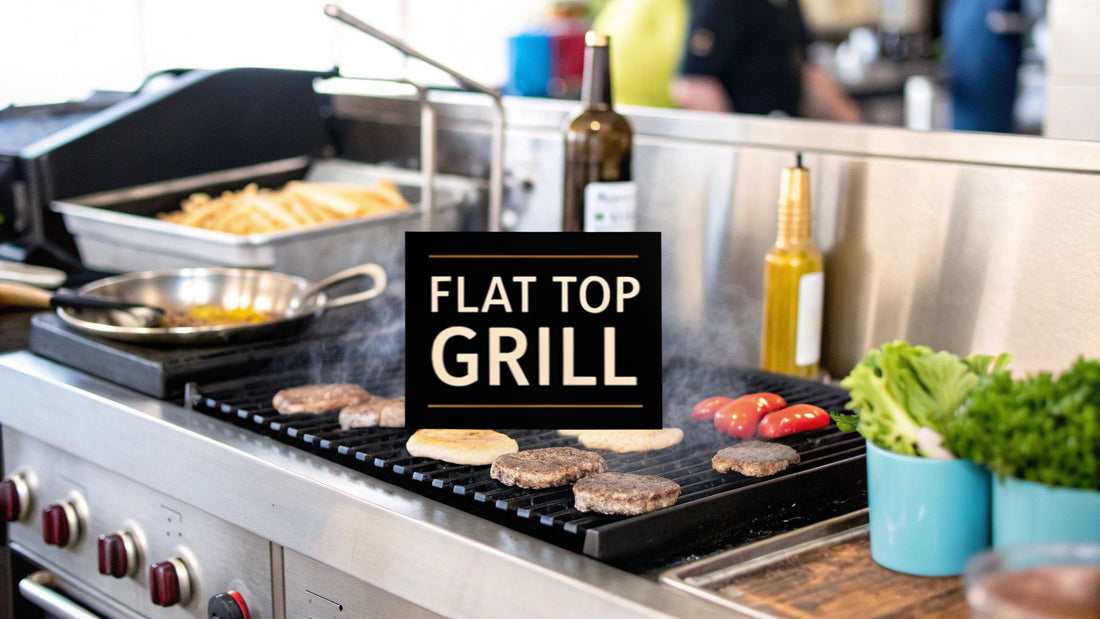
Choosing a Commercial Flat Top Grill Propane: News, Trends, and Exclusive Deals for Chefs
Share
Walk into almost any busy commercial kitchen, and you'll likely see a flat-top grill fired up and running. It’s the workhorse, the engine that powers the menu from sunup to sundown. This is where the magic happens, seamlessly transitioning from flipping morning pancakes to searing evening steaks.
This incredible adaptability is what makes it a must-have. Think of it as a chef's ultimate multi-tool. Stay informed with us as we dive into the latest industry trends and equipment insights that can give your kitchen a competitive edge.
The Indispensable Workhorse of Your Kitchen
A single, massive cooking surface lets a chef juggle multiple orders at once, pushing out food at an incredible pace during the dinner rush. In a fast-moving kitchen where every second and every inch of space counts, that kind of efficiency is gold.
Why This Grill Is a Kitchen Essential
This isn't just a hunch; the numbers back it up. The global market for commercial griddles, which includes the commercial flat top grill propane models we're talking about, hit around USD 7.8 billion in 2023.
Analysts expect it to keep growing at a solid clip of about 6.5% each year through 2033. This surge is fueled by massive demand from restaurants and hotels who know a good thing when they see it. For a deeper dive, check out the full market analysis from DataHorizzon Research.
This trend really highlights the value these grills bring to the table. They’re a smart investment because they consistently deliver, no matter what you throw on them. Here’s why they’ve become such a non-negotiable piece of equipment:
- Menu Versatility: You can sear, sauté, toast, and warm all from one spot. It’s like having multiple pans going at once, but without the clutter.
- High-Volume Output: The huge, flat surface is built for cooking in large batches. This means you can keep pace with a flood of tickets during your busiest hours without breaking a sweat.
- Consistent Heat Distribution: Forget about hot spots. A quality flat top spreads heat evenly across the entire surface, so every single item gets cooked perfectly every time.
My goal with this guide is to help you see beyond the steel. I want you to understand how to pick the right grill, use it to its full potential, and keep it running smoothly to completely transform your kitchen's workflow.
Why Propane Power Delivers a Competitive Edge
In the controlled chaos of a commercial kitchen, your equipment's performance can be the difference between a smooth service and a complete disaster. This is where propane-powered flat top grills really come into their own, giving you an immediate, noticeable advantage over electric and even natural gas models. The secret is all about raw power and instant response.
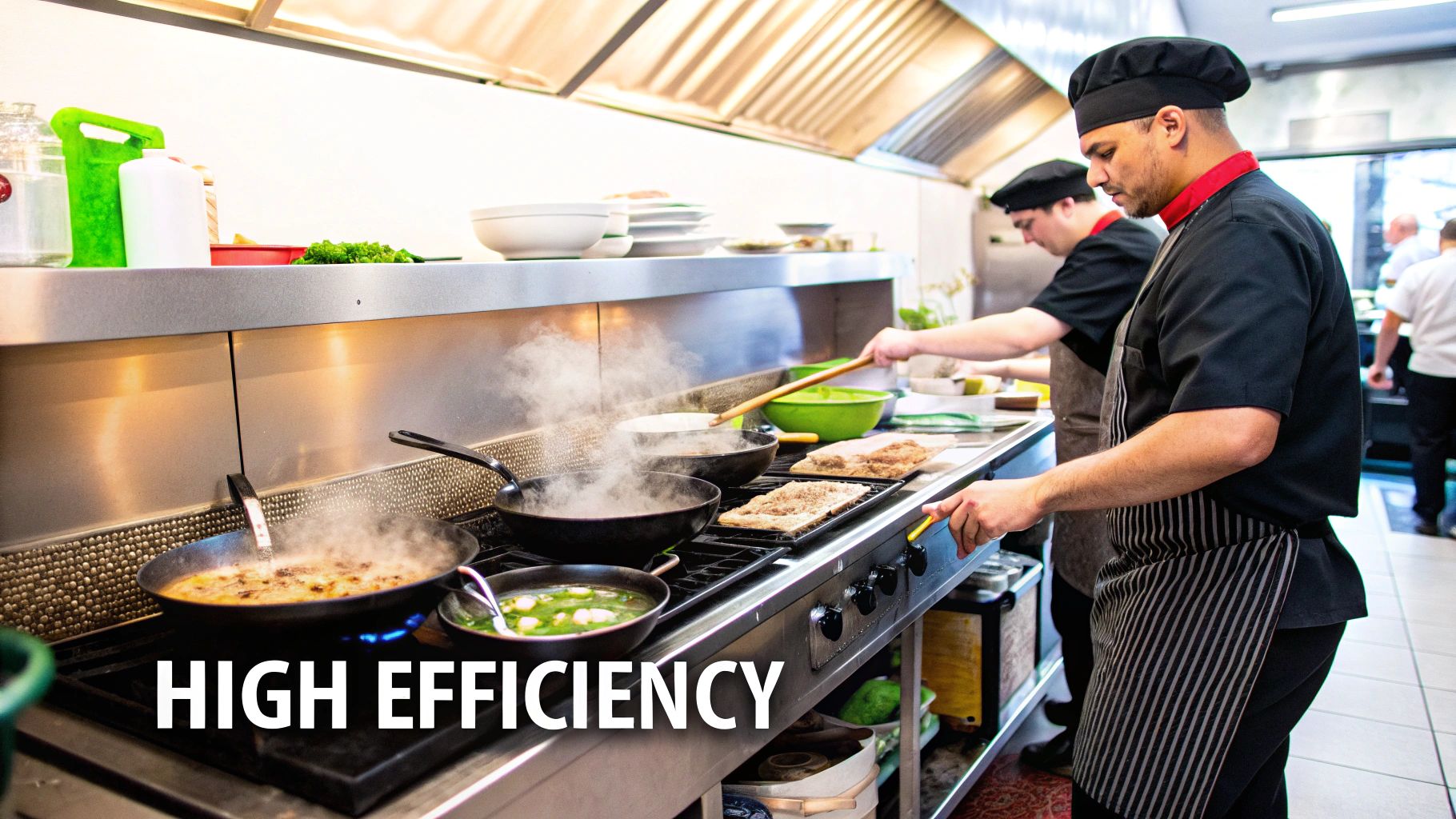
Think about it like this: a commercial flat top grill propane model handles like a high-performance sports car, while its electric counterpart is more like a heavy sedan. You get instant heat and can make lightning-fast temperature adjustments. When an order for a rare steak hits the rail right after you just finished delicate crepes, you can crank the heat up or dial it down in seconds, not minutes. That kind of agility is what keeps the line moving and ensures every plate goes out perfect.
This level of control is a huge reason why gas grills are the go-to in the professional world. It's a massive market, too. Forecasts show the commercial griddle market hitting USD 2.06 billion in 2024 and climbing to USD 2.4 billion by 2030. That growth is built on the back of the reliability and precision that chefs demand from fuels like propane. You can dig deeper into these numbers in Strategy MRC's comprehensive report.
Unlocking Efficiency and Portability
Aside from just cooking better and faster, propane brings some serious operational advantages that directly affect your wallet. For starters, installation is usually a whole lot simpler and cheaper than having a dedicated natural gas line run, especially if you're in an older building or have a tricky layout. That alone can save you thousands of dollars right out of the gate.
The real game-changer with propane is its portability. It untethers your kitchen from fixed utility lines, opening up a world of new revenue streams that are simply impossible with other fuel sources.
This freedom is what makes a modern food business thrive. Just think about how different operations can cash in on the mobility of a commercial propane flat top grill:
- Food Trucks: Propane is the undisputed king of mobile kitchens. It’s what gives you the high-heat muscle to churn out restaurant-quality food from the side of a street.
- Caterers: Imagine being able to bring your professional-grade grill setup to a wedding, a corporate picnic, or a music festival. Your entire service area just exploded.
- Restaurants with Patios: Want to run an outdoor grilling station for a summer special or a weekend event? With propane, you can set it up in a snap and create an experience that pulls in more customers.
At the end of the day, picking propane isn’t just a fuel choice—it’s a business strategy. It gives your kitchen the speed to crush the dinner rush, the efficiency to keep costs down, and the flexibility to chase opportunities well beyond your own four walls. It’s an edge you can feel on every single shift.
Decoding the Features That Truly Matter
When you're shopping for a new commercial flat-top grill, it’s easy to get bogged down in a sea of spec sheets. Let's cut through the noise. A few key features really determine whether a grill will be a kitchen workhorse or a daily frustration. Getting these right means investing in a piece of equipment that won't let you down during a chaotic dinner rush.
The Heart of the Grill: Plate Thickness
The single most important factor is the grill plate thickness. I like to think of that heavy slab of steel as a "thermal battery." The thicker it is, the more heat it can store.
High-quality grills typically feature a 1-inch thick plate. This massive heat reservoir means the surface temperature stays incredibly consistent, even when you slap down a bunch of cold steaks. It recovers its heat almost instantly, which translates to faster, more even cooking and no frustrating temperature drops right when you need it most.
The Power Behind the Plate
If the plate is the heart, the burners are the engine. A grill’s power is measured in British Thermal Units (BTUs), which is just a fancy way of saying how much heat it can generate. More BTUs mean the grill gets screaming hot faster and holds that temperature for a perfect sear.
You'll notice most commercial units have multiple burners. For instance, a 24-inch model will often have two burners, giving you two independent 12-inch cooking zones. This is a game-changer. You can have one side ripping hot for burgers while the other gently warms buns or sautés vegetables. It’s all about flexibility.
This infographic gives you a quick visual on the core numbers you'll be looking at.
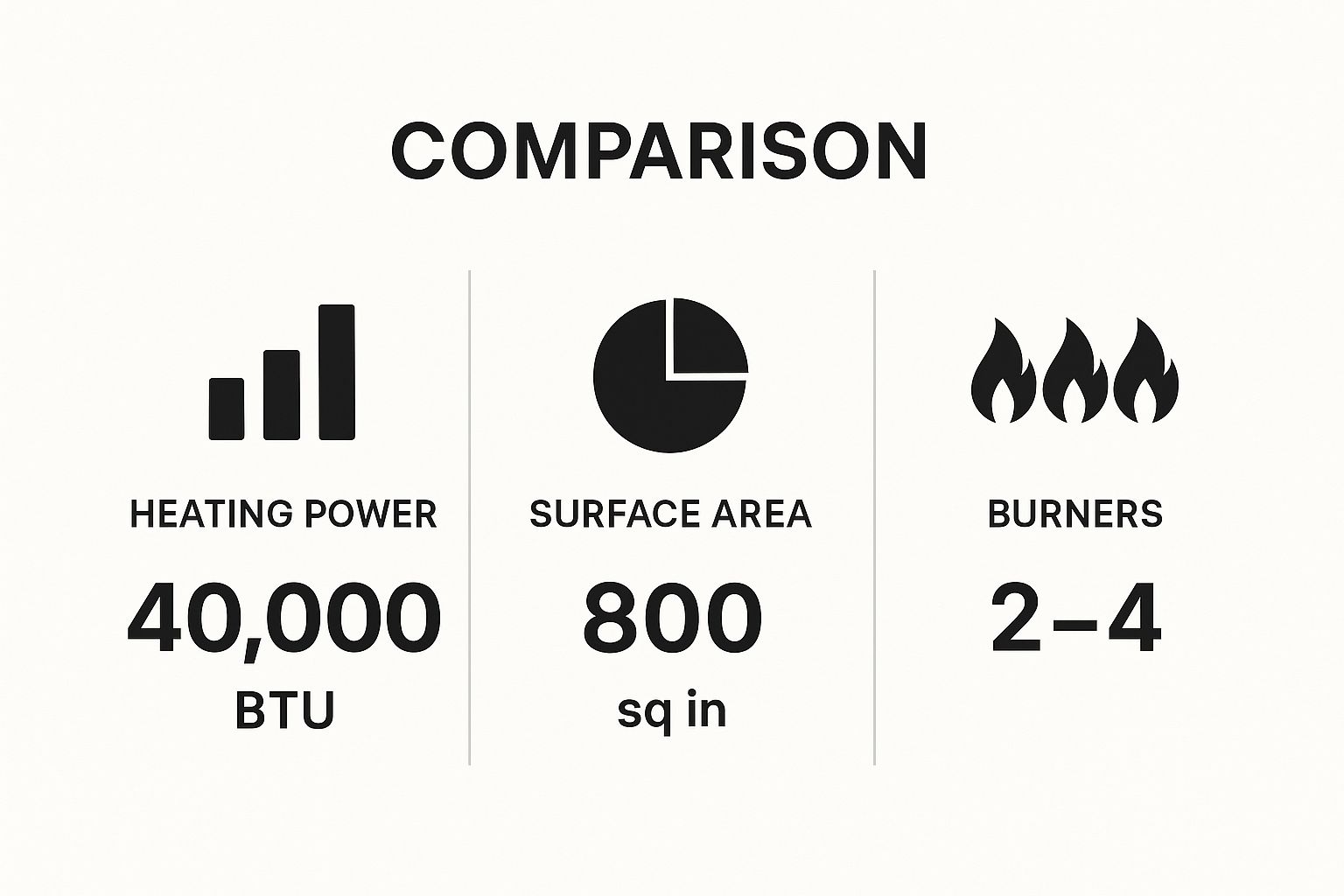
As you can see, BTUs, surface area, and the number of burners all come together to paint the full picture of a grill's cooking power and capacity.
Surface Material and Daily Operations
Beyond the raw power, the cooking surface itself makes a huge difference in your day-to-day workflow. Your main choices are standard steel and chrome-plated.
Grill Plate Thickness and Material Comparison
To make sense of the options, it helps to see how they stack up. This table breaks down how plate material and thickness impact everything from heat retention to cleanup.
| Feature | Standard Steel Plate | Chrome-Plated Plate |
|---|---|---|
| Heat Retention | Excellent, especially when 1-inch thick. Becomes a "thermal battery." | Good, but the chrome layer can slightly insulate the steel. |
| Heat Transfer | Direct and powerful. Perfect for searing and consistent cooking. | Very efficient and even, with fewer hot spots. |
| Maintenance | Requires regular seasoning to create and maintain a non-stick surface. | Does not require seasoning. Much easier to clean. |
| Durability | Extremely tough. Can handle heavy use with metal spatulas and scrapers. | More delicate. Prone to scratching from metal utensils. |
| Best For | All-purpose cooking, from breakfast to dinner service. The go-to for most kitchens. | Delicate items like fish and eggs; kitchens where flavor transfer is a major concern. |
Ultimately, standard steel is the rugged, all-around champion, while chrome offers a slick, easy-to-clean surface at the cost of some durability.
Finally, don't forget the unsung heroes of good grill design. A deep, easily removable grease drawer is non-negotiable for keeping things clean and safe. And look for fully welded, sturdy construction—it's what keeps the unit from warping or falling apart after a year of hard service. To see how these features come together in a real-world unit, you can find a breakdown of equipment like the Atosa griddle.
A well-designed grease management system not only simplifies cleanup but also significantly reduces flare-up risks, creating a safer environment for your entire kitchen staff.
By zeroing in on plate thickness, burner power, surface material, and those crucial practical details, you can pick a commercial flat-top grill that will be a reliable partner in your kitchen for years to come.
Matching Your Grill Size to Your Business Ambitions
Choosing the right size for your commercial flat top grill propane unit is about much more than just finding an open spot on your kitchen line. It's a strategic move that dictates how fast you can serve customers, how ambitious your menu can be, and ultimately, how much money you can make. The right grill shouldn't be a bottleneck; it should feel like a natural extension of your culinary vision.
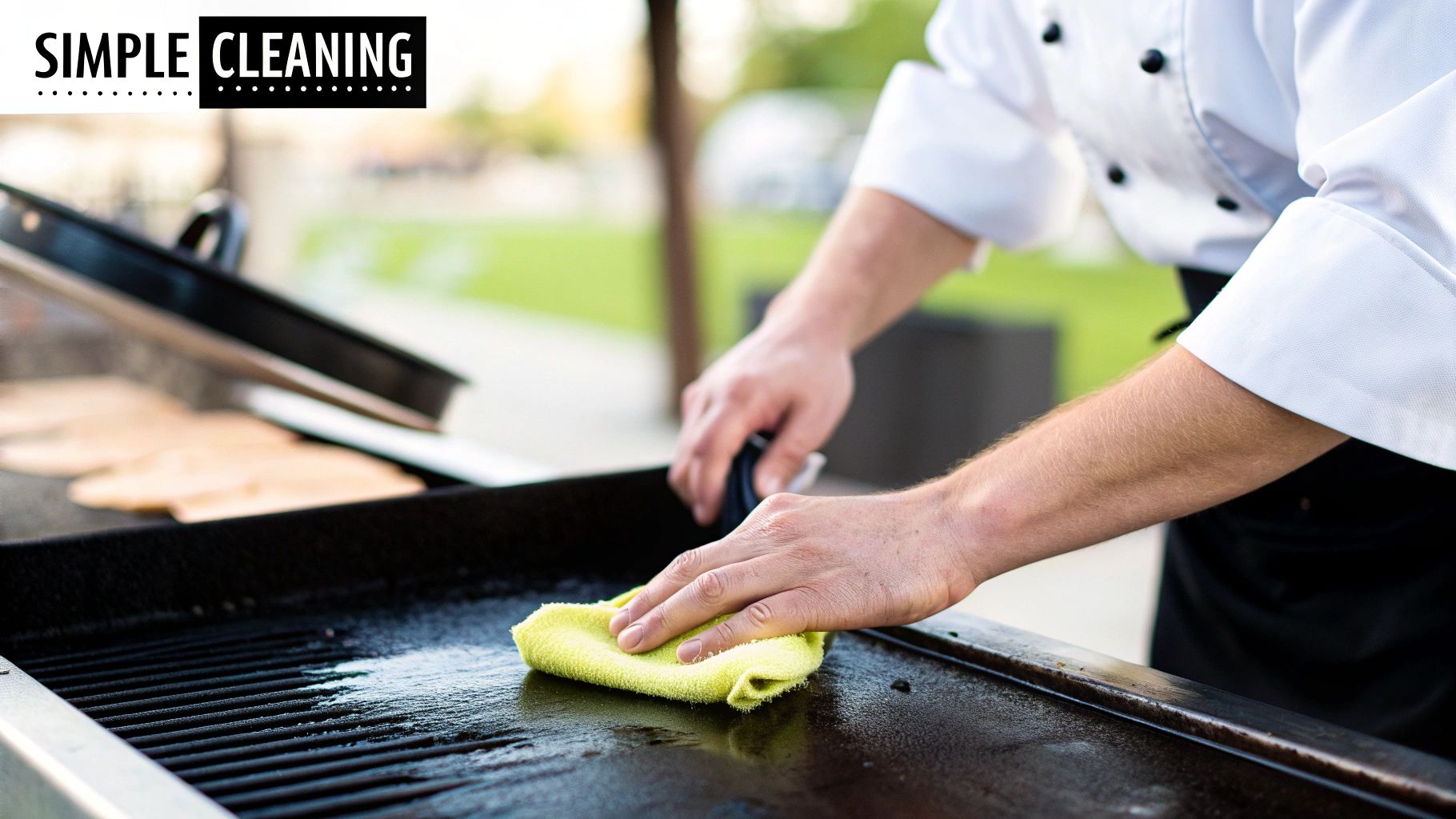
Think about the difference between a small coffee shop and a classic, high-volume diner. The coffee shop might just be slinging breakfast sandwiches, making a nimble 24-inch model a perfect fit. It heats up fast and doesn't hog precious counter space. That bustling diner, on the other hand, needs a 60-inch or even a 72-inch monster to keep up with simultaneous orders for pancakes, burgers, and cheesesteaks without breaking a sweat.
This kind of strategic thinking is happening in kitchens everywhere. In fact, the commercial griddle market was valued at USD 576.4 million in 2025 and is expected to climb to USD 912.4 million by 2035. This growth is powered by businesses just like yours—quick-service restaurants, food trucks, and ghost kitchens that rely on the sheer versatility of a flat top. You can dive deeper into this trend in the full market report from Future Market Insights.
Sizing Up Your Operational Needs
To land on the perfect size, you need to be honest about your menu, your busiest hours, and where you see your business going. Don't just buy for the kitchen you have today; buy for the business you're aiming to build.
- 24 to 36-Inch Grills: These are the go-to for businesses with a tight, focused menu. They're perfect for small cafes, concession stands, or bars where the grill is a supporting player, not the star of the show.
- 48-Inch Grills: For many small to mid-sized restaurants, this is the sweet spot. A 48-inch grill gives you enough room to run a diverse menu and handle a serious rush without totally dominating your cook line. If you want to see a prime example, check out our guide on the Atosa 48-inch griddle.
- 60 to 72-Inch Grills: These are the undisputed heavyweights. Built for high-volume warfare, you'll find these workhorses in busy diners, large institutional kitchens, and steakhouses that need every square inch of cooking real estate they can get.
The Modular Approach: A Flexible Alternative
Sometimes, one giant grill isn't the answer. Have you ever considered a modular setup? Placing two smaller 36-inch grills side-by-side can be a game-changer, offering a level of flexibility a single unit just can't match.
A modular grill setup gives you built-in redundancy and far better temperature control. If one unit goes down for maintenance, the other keeps you in business. Plus, you can run two completely different temperature zones for specialized cooking.
Imagine dedicating one grill exclusively to breakfast items like pancakes and eggs while the other handles savory proteins for lunch and dinner. This setup completely prevents flavor transfer between, say, bacon and seared scallops. It also lets you scale your operation intelligently—you can simply add another unit as you grow instead of having to rip out and replace one massive piece of equipment.
Mastering Grill Maintenance for Peak Performance
You’ve made a serious investment in your commercial flat-top grill. It's the workhorse of your kitchen, and with the right care, it will pay you back shift after shift. Skipping maintenance, on the other hand, is a fast track to costly repairs and frustrating downtime. A simple, consistent cleaning routine is all it takes to protect your investment and keep it running safely and efficiently.
Think of your grill's cooktop exactly like a high-quality cast-iron pan. It needs to be seasoned. This simple process creates a natural, non-stick surface that gets better and better over time. A properly seasoned grill doesn't just make cooking easier; it's your first line of defense against rust, which can dramatically shorten the life of your equipment.
Your Daily Maintenance Checklist
The real secret to a grill that lasts isn't some massive annual teardown. It’s what you do every single day. A few dedicated minutes at the end of service will save you from major headaches down the road.
Here’s a simple routine that works wonders:
- Scrape While Hot: Don't wait for it to cool down. As soon as you're done cooking, grab a grill scraper or brick and get all that food debris and gunk off the surface.
- Clean the Surface: A little warm water or even club soda can work magic here. Use a non-abrasive pad to scrub off any leftover residue.
- Empty the Grease Trap: This isn't just about cleanliness; it's a critical safety step. Carefully pull out the grease drawer, empty it, and give it a good wash to prevent dangerous buildup and fire risks.
- Re-season Lightly: Once the cooktop is clean and completely dry, wipe on a very thin layer of cooking oil with a clean cloth. This simple step protects the steel overnight and keeps that beautiful seasoning intact.
Weekly and Monthly Deep Cleaning
Daily habits are the foundation, but you'll want to dig a little deeper on a regular basis to keep your commercial flat top grill propane unit in prime condition. Once a week, spend some extra time wiping down the backsplashes, sides, and control knobs to make sure no grease is hiding in the corners.
A well-maintained grill is about more than just cleanliness; it’s a direct reflection of your kitchen's commitment to quality and safety. Consistent maintenance ensures every dish cooked on its surface is free from carbon buildup and old flavors.
Sometimes, you'll run into stubborn, baked-on grease that a daily scrape just won't touch. For those tough jobs, you might need something with a little more muscle. To learn how to deal with heavy carbon deposits safely, check out powerful solutions like the Carbon-Off cleaner.
And once a month, take a minute to inspect the propane burners. You're looking for any blockages that could lead to hot and cold spots. A healthy, efficient burner will have a consistent blue flame. Keeping an eye on this is one of the easiest ways to ensure your grill remains profitable and dependable for years to come.
Common Questions from Chefs and Owners
Buying a commercial flat top grill propane model is a big decision. It’s the workhorse of many kitchens, so it's only natural to have a few questions before you commit. We get calls from seasoned chefs and brand-new restaurateurs all the time, and a few key topics always come up. Let's clear the air on some of the most common ones.
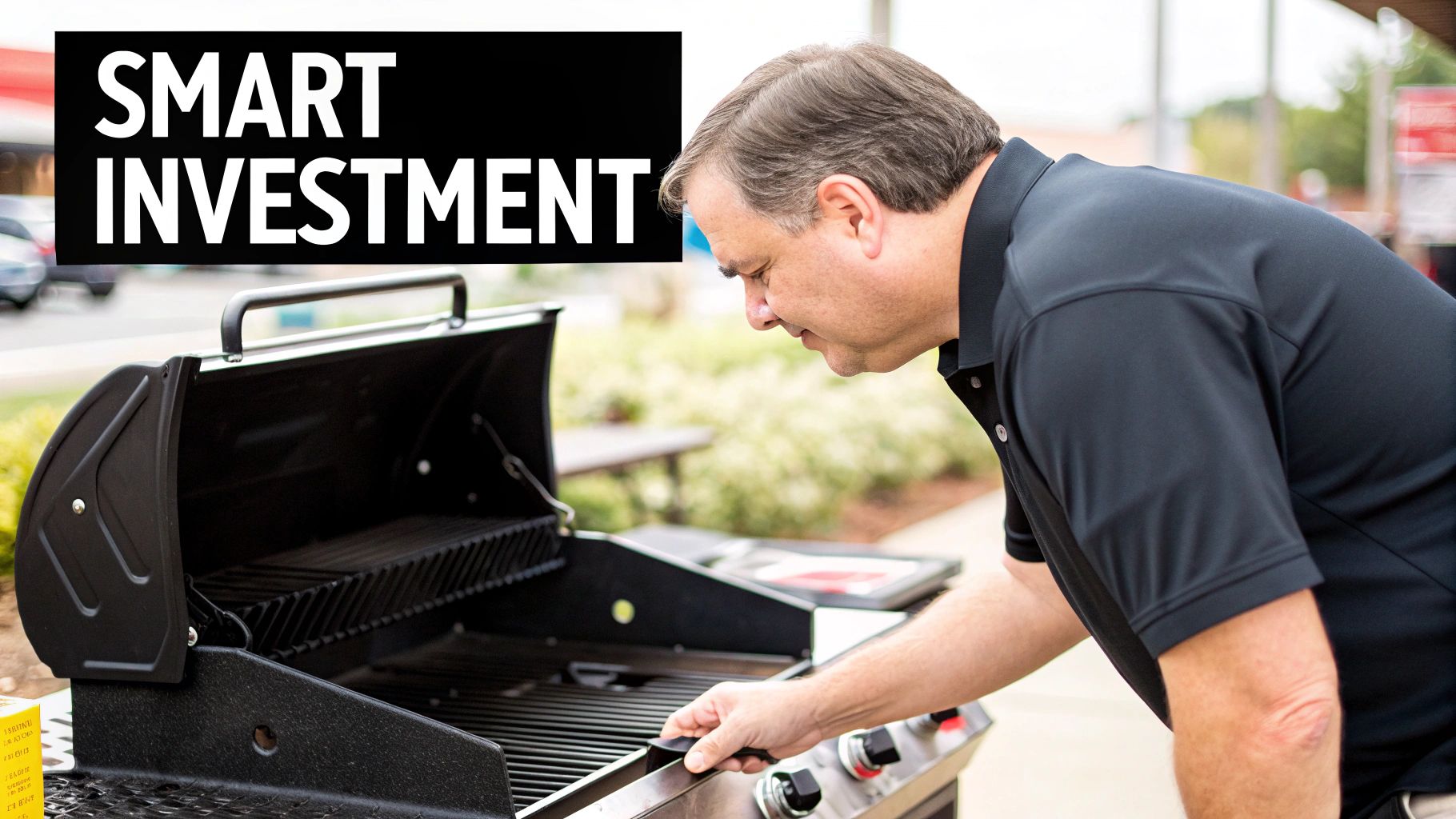
Clarifying Common Terminology and Practices
First off, is it a "griddle" or a "flat top grill"? You'll hear chefs use both terms, and honestly, in the commercial world, they're pretty much interchangeable. Both refer to a complete cooking unit with a solid, flat surface. The name doesn't really matter—what you need to focus on are the specs, like the thickness of the steel plate and the power of the burners.
Then there's seasoning. Every new grill needs a really good seasoning right out of the box to create that non-stick patina. After that initial process, it's just a matter of maintenance. A quick wipe with a bit of oil after you clean it down is usually all it takes. You shouldn’t need to do a full, from-scratch re-seasoning unless you’ve got food sticking like crazy or you've had to scrub away some serious rust.
Safety and compliance should be your top priorities during installation. Hooking up the wrong fuel type or ignoring local building codes can wreck your equipment, void the warranty, and create a massive safety risk for your team and guests.
Handling Conversions and Safety
"Can I switch this from natural gas to propane?" That's a huge one. The answer is usually yes. Most manufacturers design their grills to be convertible and even include the kit. But—and this is a big but—this is not a DIY job. You need a qualified gas technician to do it. They have to swap out the gas orifices and recalibrate the pressure regulator. Get it wrong, and you're asking for trouble.
Proper installation is completely non-negotiable. Here’s what absolutely has to happen:
- Follow the Codes: Your grill must be installed according to all local fire codes, which dictate the required clearance from walls and other flammable surfaces.
- Bring in a Pro: A professional needs to connect the propane lines, do a thorough leak check, and make sure the pressure regulator is set perfectly.
- Ventilation is Key: Never, ever fire up a commercial grill without a fully operational ventilation and fire suppression hood system directly above it.
Getting these things right from the start means your grill will be a reliable moneymaker, not a dangerous liability.
Ready to find the perfect workhorse for your kitchen? Explore a wide selection of top-tier commercial cooking equipment at Encore Seattle Restaurant Equipment and get the expert advice you need to make the right investment. Discover exclusive deals and the latest industry news at https://encoreseattle.com.
